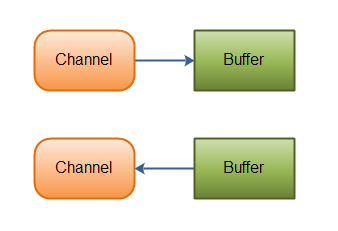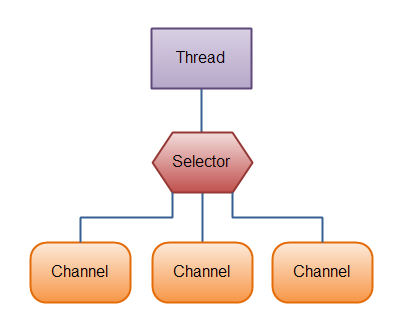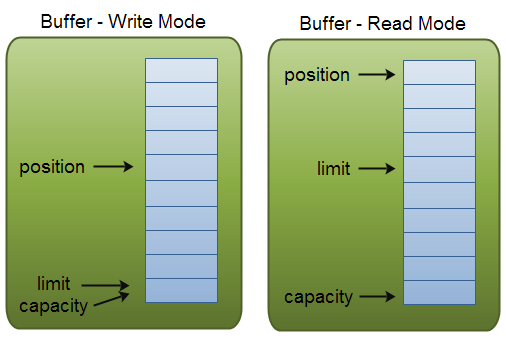1.NIO概念
NIO与传统IO相比最大的特点就是非阻塞。IO是阻塞的,当一个线程调用read或write方法时,线程必须等待文件读取完或者写完才能去执行其他任务;而NIO是非阻塞的,它允许线程请求从通道中读取数据,如果当前没有可用数据,线程可以继续执行其他操作,而不是一直阻塞。
2.NIO主要组件
NIO包含三个主要的类:
- Buffer
- Channel
- Selector
NIO有许多类组成,但是buffer,channel和selector构成了核心的API。所以接下来会主要介绍这三个类。通常,NIO中的所有IO都是以channel开始。Channel其实和IO中的stream差不多。通过channel数据能被写入buffer中,同样数据能从buffer中写入channel。如下图:
Buffer和Channel的主要子类如下所示:
- ByteBuffer ->MappedByteBuffer(实现内存映射文件)
- CharBuffer
- ShortBuffer
- IntBuffer
- FloatBuffer
- DoubleBuffer
- LongBuffer
- FileChannel
- DatagramChannel
- SocketChannel
- ServerSocketChannel
Selector允许一个线程操作多个Channel。如果你的应用程序打开了很多连接(Channel),但是每个连接上的通信量很低,那么这时候Selector就很方便。比如聊天服务器。
下图说明了selector和channel的关系:
3.Buffer
- 3.1 Capacity、Position、Limit
buffer主要有三个属性:capacity、position和limit。- capacity:buffer的容量,我们在分配buffer时会指定一个容量。当buffer达到容量之后需要清除数据才能继续向buffer中写入数据。
- position:buffer中数据写入的位置。初始为0,往buffer写入或读取一字节数据,position就会加1,当清除buffer 中数据或者由写模式切换为读模式时,position会重新置0,postion最大为capacity-1。
- limit:在写模式中,limit就等于buffer的capacity。在读模式中,limit是指可以从buffer中读取的数据量的限制。

3.2 Allocating a Buffer
想要得到一个buffer首先必须分配它,每个Buffer类中都提供了一个静态方法allocate()来分配buffer。1
2ByteBuffer buf = ByteBuffer.allocate(2048);
CharBuffer buf = CharBuffer.allocate(1024);3.3 Writing Data to a Buffer
往buffer中写入数据有两种方式:- 一是调用buffer的put方法写入数据,如buf.put(127);
- 二是将数据通过channel写入buffer,如int num = channel.read(buf);
flip()方法是将buffer从写模式切换到读模式,这个会重新设置position和limit的值。
- 3.4 Reading Data from a Buffer
从buffer中读取数据也有两种方式:- 一是调用buffer的get方式读取数据,如buf.get();
- 二是读取buffer数据到channel中,如int bytesWritten = inChannel.write(buf);
- 3.5 rewind()、clear()、compact()
- rewind()可以将position值重新置为0,这样就可以重新读取buffer中的数据。
- clear()方法将设置poistion为0,设置limit为capacity,clear虽然不会清除buffer中的数据,但是后续写入的数据会覆盖之前的数据,相当于清空了buffer数据。
- compact()和clear不同,它会将之前的数据移向左边,将position设置为最后一个未读数据,从这个基础上再开始写入。
- 3.6 mark()、reset()
调用mark()方法可以标记当前buffer中的position,执行一些操作之后调用reset()可以可以将position回到刚才标记的位置。1
2
3
4
5buffer.mark();
//call buffer.get() a couple of times, e.g. during parsing.
buffer.reset(); //set position back to mark.
4.Channel
所有的NIO操作都是始于channel,数据的读取和写入都会经过channel。
4.1 FileChannel(文件通道,用于文件的读和写)
不能设置为非阻塞模式,只能是阻塞模式- Open a FileChannel
使用一个FileChannel之前必须先打开它,但是不可能直接打开FileChannel,必须通过InputStream,OutputStream或者RandomAccessFile来获取一个FileChannel。RandomAccessFile aFile = new RandomAccessFile("data/nio-data.txt", "rw");FileChannel inChannel = aFile.getChannel(); Read Data from a FileChannel
ByteBuffer buf = ByteBuffer.allocate(48);int bytesRead = inChannel.read(buf);
上面bytesRead如果返回-1,说明读取完了Write Data to a FileChannel
String newData = "New String to write to file..." + System.currentTimeMillis();ByteBuffer buf = ByteBuffer.allocate(48);buf.clear();buf.put(newData.getBytes());buf.flip();while(buf.hasRemaining()) {channel.write(buf);}- Close a FileChannel
channel.close() - FileChannel Position
当你想在一个特定位置读取或写入FileChannel,你可以通过position()方法获取FileChannel的当前位置,然后你可以通过position(long newPosition)方法设置新的postiion。long pos=channel.position();channel.position(pos + 123); - FileChannel Size
FileChannel对象的size()方法返回通道连接的文件的文件大小。 - FileChannel Truncate
调用FileChannel.truncate()方法来截断文件。当您截断一个文件时,您将它以给定的长度截断。channel.truncate(1024); - FileChannel Force
force()方法将所有未写入的数据从通道刷新到磁盘。force()方法以一个布尔值作为参数,告诉文件元数据(权限等)是否也应该刷新。
- Open a FileChannel
4.2 SocketChannel(用于通过TCP读写数据)
SocketChannel是连接到TCP网络套接字的通道。它相当于Java NIO的Java网络套接字。
打开一个SocketChannel的代码如下:SocketChannel socketChannel = SocketChannel.open();socketChannel.connect(new InetSocketAddress("http://xxx.com", 80));
SocketChannel的读写和FileChannel没什么区别。4.3 ServerSocketChannel(TCP对应的服务端,用来某个端口进来的请求)
ServerSocketChannel可以用来监听进来的tcp连接,就像java标准网络中的ServerSocket。1
2
3
4
5
6
7
8
9
10//实例化
ServerSocketChannel serverSocketChannel = ServerSocketChannel.open();
//监听端口
serverSocketChannel.socket().bind(new InetSocketAddress(9999));
while(true){
//监听进来的tcp连接,创建SocketChannel
SocketChannel socketChannel = serverSocketChannel.accept();
//do something with socketChannel...
}4.4 DatagramChannel(用于通过UDP从网络上读写数据)
DatagramChannel是一个能够发送和接收UDP包的通道,由于UDP是无连接的,所以在默认情况下,您不能像从其他通道那样读写DatagramChannel。你只可以发送和接收数据包。
监听端口1
2DatagramChannel channel = DatagramChannel.open();
channel.socket().bind(new InetSocketAddress(9999));
接收数据1
2
3ByteBuffer buf = ByteBuffer.allocate(48);
buf.clear();
channel.receive(buf);
发送数据
1 | String newData = "New String to write to file..."+ System.currentTimeMillis(); |
- 4.5 Channel Transfers
在NIO中,如果其中一个channel是FileChannel时,则可以将数据直接从一个通道传到另一个通道。
FileChannel中的transferFrom()方法能够将数据从一个源通道传送到FileChannel中。1
2
3
4
5
6
7RandomAccessFile fromFile = new RandomAccessFile("fromFile.txt", "rw");
FileChannel fromChannel = fromFile.getChannel();
RandomAccessFile toFile = new RandomAccessFile("toFile.txt", "rw");
FileChannel toChannel = toFile.getChannel();
long position = 0;
long count = fromChannel.size();
toChannel.transferFrom(fromChannel, position, count);
FileChannel中的transferTo()方法可以将数据从FileChannel中传送到其他通道。1
2
3
4
5
6
7RandomAccessFile fromFile = new RandomAccessFile("fromFile.txt", "rw");
FileChannel fromChannel = fromFile.getChannel();
RandomAccessFile toFile = new RandomAccessFile("toFile.txt", "rw");
FileChannel toChannel = toFile.getChannel();
long position = 0;
long count = fromChannel.size();
fromChannel.transferTo(position, count, toChannel);
5.Selector
Selector可以检查一个或多个channel,并确定哪些channel准备就绪。通过这种方式,一个线程可以管理多个channel,从而管理多个网络连接。
5.1 创建Selector和注册Channel到Selector
1 | Selector selector = Selector.open(); |
上面第二行用于设置非阻塞模式,由于Selector必须工作在非阻塞模式中,所以FileChannel不能使用Selector。
register方法的第二个参数是一个int型参数(使用二进制标记位,叫interest set),用于表明channel需要监听哪些感兴趣的事件,共有以下四种事件。
- Read
对应SelectionKey.OP_READ(值为1<<0),表示channel可以读取数据。 - Write
对应SelectionKey.OP_WRITE(值为1<<2),表示channel可以写入数据。 - Connect
对应SelectionKey.OP_CONNECT(值为1<<3),表示channel建立连接。 - Accept
对应SelectionKey.OP_ACCEPT(值为1<<4),表示channel可以接收传入的连接。
如果想要设置多个事件,则将对应的key进行与操作。如下:
1 | int interestSet = SelectionKey.OP_READ | SelectionKey.OP_WRITE; |
5.2 SelectionKey
上面注册channel时register方法会返回一个SelectionKey对象。这个SelectionKey对象包含以下属性:
Interest Set
Interest Set中是channel感兴趣的事件集合,你可以通过下面的方法获取Interest Set。1
2
3
4
5
6int interestSet = selectionKey.interestOps();
boolean isInterestedInAccept = interestSet & SelectionKey.OP_ACCEPT;
boolean isInterestedInConnect = interestSet & SelectionKey.OP_CONNECT;
boolean isInterestedInRead = interestSet & SelectionKey.OP_READ;
boolean isInterestedInWrite = interestSet & SelectionKey.OP_WRITE;Ready Set
Ready Set 表示的是channel已经准备好的事件集合。通常在选择一个channel之后来访问这个集合。
1 | int readySet = selectionKey.readyOps(); |
Channel + Selector
获取channel和selector比较简单。1
2Channel channel = selectionKey.channel();
Selector selector = selectionKey.selector();Attaching Objects
可以将对象附加到SelectionKey对象上,这是识别channel或者将信息附加到channel上的方便方法。
1 | selectionKey.attach(theObject); |
也可以在register的时候附加对象。
1 | SelectionKey key = channel.register(selector, SelectionKey.OP_READ, theObject); |
5.3 Select Channel
通过Selector的select方法我们可以选择一个channel。select方法主要有三个:
- select():这个方法会阻塞直到至少一个channel准备好。
- select(long timeout):和select()功能类似,只是制定了阻塞时间。
- selectNow():这个不会阻塞,不管有没有准备好的channel,都会立即返回。
上面select方法的返回值是一个int,表示有多少个通道准备好。如果没有对第一个准备好的通道做任何操作,那么会有两个准备好的通道,但是在每个select()调用之间只有一个通道准备好。
- wakeUp():这个方法是用来唤醒等待在 select() 和 select(timeout) 上的线程的。如果 wakeup() 先被调用,此时没有线程在 select 上阻塞,那么之后的一个 select() 或 select(timeout) 会立即返回,而不会阻塞,当然,它只会作用一次。
5.5 Full Selector Example
1 | Selector selector = Selector.open(); |
6.NIO Pipe
NIO Pipe是两个线程之间一个单向的数据连接。Pipe有一个source channel和一个sink channel。将数据写入sink channel,然后可以从source channel读取这些数据。
1
2
3
4
5
6
7
8
9
10
11
12
13
14
15
16
17
18//open pipe
Pipe pipe = Pipe.open();
//write data to sink channel
Pipe.SinkChannel sinkChannel = pipe.sink();
String newData = "New String to write to file..." + System.currentTimeMillis();
ByteBuffer buf = ByteBuffer.allocate(48);
buf.clear();
buf.put(newData.getBytes());
buf.flip();
while(buf.hasRemaining()) {
sinkChannel.write(buf);
}
//read data from source channel
Pipe.SourceChannel sourceChannel = pipe.source();
ByteBuffer buf = ByteBuffer.allocate(48);
int bytesRead = sourceChannel.read(buf);